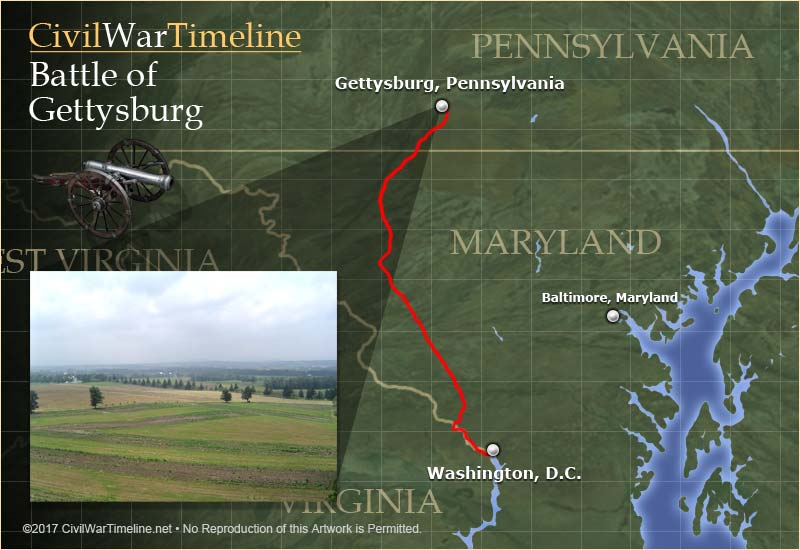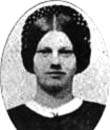

UNION VICTORY
COMMAND(S):
General George G. Meade ARMY FORCE(S):
Army of the Potomac STRENGTH:
104,256 men CASUALTIES*:
23,049 men (22.1%)
* Includes killed, wounded, and missing.
General George G. Meade ARMY FORCE(S):
Army of the Potomac STRENGTH:
104,256 men CASUALTIES*:
23,049 men (22.1%)
* Includes killed, wounded, and missing.
COMMAND(S):
General Robert E. Lee ARMY FORCE(S):
Army of Northern Virginia STRENGTH:
73,000 men CASUALTIES*:
25,000 men (34.2%)
* Includes killed, wounded, and missing.
General Robert E. Lee ARMY FORCE(S):
Army of Northern Virginia STRENGTH:
73,000 men CASUALTIES*:
25,000 men (34.2%)
* Includes killed, wounded, and missing.
Force Strength




Casualties Comparison




Day-by-Day Timeline of Events
July 1, 1863
In the northwest of Gettysburg, at Marsh Creek at about 5:30AM, the first shots of the Battle of Gettysburg are fired between Confederate and Union forces.
July 1, 1863
At 8:00AM, Confederate forces - as part of General Henry Heth's division - under the direction of General James J. Archer and General Joseph R. Davis march on Gettysburg.
July 1, 1863
At 10:00AM, during the fighting at Gettysburg, Union General John F. Reynolds is killed.
July 1, 1863
General Solomon Meredith's "Iron Brigade" repels General Archer's Confederates and captures Archer and a few hundred others.
July 1, 1863
At 2:00PM Major General Robert E. Rodes moved his troops against the Union right flank.
July 1, 1863
At 2:00PM, Union General Meade calls on General Winfield S. Hancock to succeed the slain General Reynolds.
July 1, 1863
Upon arriving on scene at about 2:30PM, General Robert E. Lee surveys the battlefield from Herr Ridge.
July 1, 1863
General Lee advances General Heth and William Dorsey Pender's forces. General Heth is wounded.
July 1, 1863
At 3:30PM General Schurz units retreat under attacks from General Jubal A. Early. Their retreat is through the town of Gettysburg itself.
July 1, 1863
At 4:00PM General Pender pushes Union forces to retreat into Gettysburg proper as well as into Cemetery Hill.
July 1, 1863
At 4:30PM, Union forces retreat from Gettysburg and take up fortified positions at the town's south, in Cemetery Hill.
July 1, 1863
At 4:30PM, General Lee provides General Ewell with the option to attack Union forces at Cemetery Hill if an advantage can be had and maintained. Lee understands the Federal forces hold positions on high ground. Ewell does not move on the enemy - perhaps missing a tremendous opportunity to turn the tide of the battle on its first day.
July 2, 1863
At 4:00PM, Federal positions are assailed by Confederate elements at Little Round Top and Devil's Den. Devil's Den falls to the attackers but the defenders at Little Round Top hold out.
July 2, 1863
At 5:30PM, Wheat Field and Peach Orchard, Union-held named areas to the Southwest of Gettysburg, are attacked by forces under the command of General Lafayette McLaws.
July 2, 1863
The ownership of Wheat Field is changed some four times before General Sickle's forces are pushed to the base of Little Round Top. The defensive stand there holds off the Confederates however.
July 2, 1863
Union forces continue to hold primary positions though the Confederates claim some terrain against them - particularly at Cemetery Hills and Culp's Hill.
July 3, 1863

July 3, 1863
From 5:30AM until 10AM, Confederate forces make repeated attempts to unseat and drive off Union forces at Culp's Hill. Little ground is gained in the fighting.
July 3, 1863
Union-held Seminary Ridge is attacked by forces under the command of General Pickett, General Pettigrew and General Trimble.
July 3, 1863
At 3:30PM, General Stannard leads his Union troops against the side of General Pickett's charging division.
July 3, 1863
By 3:45PM, Confederate forces have advanced as much as they will in the battle as Union lines hold.
July 3, 1863
General Farnsworth and his cavalry forces suffer considerable losses against the Confederate lines - the charge called by General Kilpatrick against General Longstreet's position southwest of Big Round Top.
July 3, 1863
At the age of 26, cavalry General Elon J. Farnsworth is killed at the Battle of Gettysburg after a cavalry charge led by General Kilpatrick. Farnsworth protested the action but obeyed nonetheless.
July 3, 1863
At the end of the battle to control Gettysburg (a decisive Union victory), over 57,000 persons became casualties, many wounded, with 23,055 belonging to the Union lines and as many as 28,000 suffered by the Confederacy. Wounded number over 25,000 combined. The Confederacy suffered mightily in terms of officer-level depletion.

